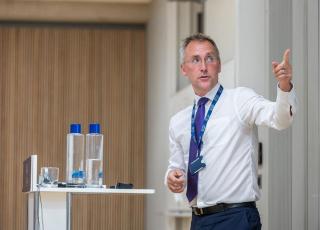Our resources thrust participants into the heart of real-world scenarios, from crisis management in the UK during the Covid-19 pandemic to cross-party education reform in Brazil.
Many of our resources are available on The Case Centre distribution platform. Educators who are registered with the site can access free review copies of our case studies, teaching notes, and other materials.
To inquire about our other cases or background materials, please contact us at casecentre@bsg.ox.ac.uk.
Sign here: politics and integrity in public administration
When Jay Adan, the most senior civil servant in his state’s Ministry of Internal Affairs, discovered irregularities in the selection of candidates for posts in his ministry, he suspected the minister may have interfered for his own political gain. Should Adan compromise his values by approving a corrupt process or risk his career and the valuable work he was doing by explicitly rejecting the list?
As the senior most civil servant in the Ministry of Internal Affairs of Mountain State, Jay Adan was required to approve any new recruits hired in the interior ministry. When he received a list of candidates recommended for vacant posts in the Mountain State Emergency Services, one of his ministry’s departments, he suspected that the recruitment had not been meritocratic. His personal investigation suggested that the candidates chosen were unqualified, and that more candidates were being recruited than the number of actual vacancies. Patronage was a rampant issue in the region, and political leaders frequently used recruitment cycles to garner support among voters before elections. Adan believed it was likely that the minister of internal affairs was interfering with the recruitment to recommend individuals from his key constituencies in time for elections. Adan considered it unethical to approve a corrupt process, but explicitly rejecting the list could cost him his career and jeopardise the important projects he was working on. Running out of time and options, Adan needed to decide what to do.
- Understand and explore different moral frameworks with which to approach a dilemma of institutional integrity;
- Consider various strategies for responding to a corrupt request in public service and the compromises each may entail;
- Develop an understanding of one's own values as they relate to public sector leadership.
Red alert: North Korea crisis simulation
The North Korean regime is among the most acute potential sources of global instability today, affecting and shaping complex regional dynamics in East Asia. In this 1.5-day exercise, participants conduct a crisis simulation centred around a fictional crisis scenario emerging in North Korea. Participants are divided into six teams, representing China, Japan, North Korea, Russia, South Korea and the United States. Each team must pursue its own national policy objectives, and each participant has a specific role within their team.
On 14 April 2023, the Democratic People's Republic of Korea announced that it had tested its ‘most powerful’ missile to date. A breakthrough in its weapons technology, the new solid-fuel ballistic missile was designed for rapid deployment – leaving little time to be intercepted by an adversary. Experts believed it had long-range or even intercontinental capabilities. With the launch, North Korea’s Supreme Leader Kim Jung Un sent a warning: ‘We will strike with deadly force and respond aggressively until the enemy gives up its idle strategy and foolish behaviour and so that it will suffer in endless fear.’ Just weeks earlier, two of North Korea’s stated enemies, the United States and Republic of Korea , conducted the largest joint military exercises in South Korea in five years. The two militaries maintained that the drills were routine and defensive, a response to North Korean ‘aggression’. But North Korea’s state media viewed them as moves of ‘frantic war preparation’. Tensions were ratcheting up in an already volatile region.
This dynamic crisis simulation picks up when communication between North and South Korea breaks down following North Korea’s missile tests. Groups of six to nine participants are allocated roles in the governments of North Korea, Republic of Korea, China, USA, Japan, and Russia to solve an escalating international crisis consisting of military, health, and economic emergencies. Over the course of five phases, participants must take actions according to their roles and their allocated country’s interests.
- Develop the skills of working in a team in a high-pressure, high-stakes context;
- Understand the utility and limitations of different levers of national power;
- Analyse the stability challenges posed by the DPRK;
- Explore the dynamics of the China-US relationship.
Tax reform in Colombia: a moment for ‘greatness, consensus and solidarity’?
In April 2021, Colombian President Ivan Duque’s administration put forward an urgently needed tax-reform package known as the ‘Sustainable Solidarity Bill’. Aiming to raise state revenues, the bill also targeted key areas of weakness in the taxation system: its complexity, inefficiency, and low redistribution. The bill was widely hailed by tax experts as being fair and technically sound.
However, before it could be debated in Congress, the bill triggered widespread protests and public criticism, drawing on a general mood of disenchantment with government. Opponents saw the bill as targeting Colombia’s middle class, which was already struggling in light of the pandemic. Of particular concern was the bill’s proposed reform of the country’s VAT regime, notably the removal of VAT exclusions and exemptions from many goods and services, including some in the ‘basic family basket’. While poorer Colombians would receive compensation for their VAT payments, middle-class households would not.
The government had to withdraw the bill, and the finance minister resigned. The case study picks up the story in May 2021, when the responsibility of redrafting the taxation reform fell on José Manuel Restrepo, Colombia’s new finance minister. How could he meet the bill’s revenue and fairness objectives whilst placating the middle-class?
- Learn key concepts of direct and indirect taxation;
- Design an optimal commodity-tax policy given specific contextual constraints;
- Balance technical and political requirements for a policy change during social unrest;
- Build support for unpopular yet necessary policy changes through strong communication strategies and stakeholder engagement.




